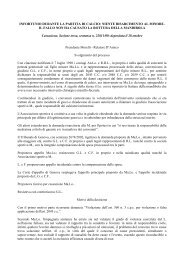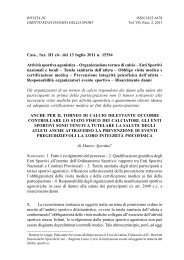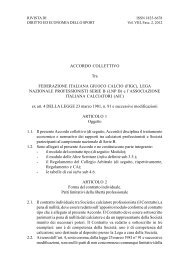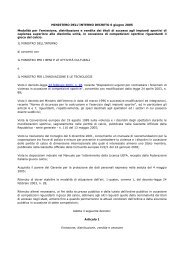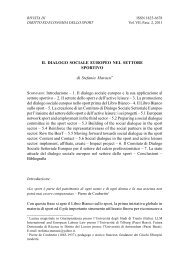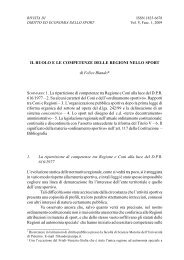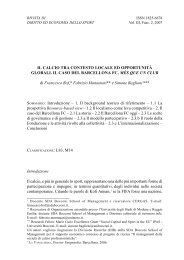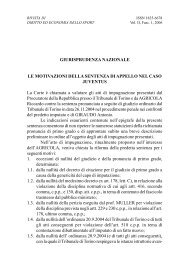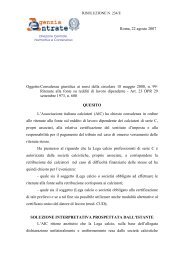You also want an ePaper? Increase the reach of your titles
YUMPU automatically turns print PDFs into web optimized ePapers that Google loves.
Globalization of the sports economy 17<br />
global market for sport broadcasting is that <strong>it</strong> operates under imperfect compet<strong>it</strong>ion.<br />
All depends on whether the market is in short supply (excess demand) or short<br />
demand (excess supply). The short side of the market usually imposes <strong>it</strong>s transaction<br />
cond<strong>it</strong>ions to those competing together on the long side of the market. The different<br />
forms of the sport broadcasting market are: 9 (a) a monopoly when only one organizer<br />
supplies his/her exclusive sports event to competing TV channels (consider the<br />
IOC offering Olympic Games, the FIFA w<strong>it</strong>h the football World Cup). In a monopoly<br />
market, price is relatively high, broadcasting rights are expensive and revenues<br />
accruing to the organizer are big; (b) an oligopsonistic monopoly when only one<br />
event organizer is facing very few potential buyers – TV channels (UEFA Champions<br />
League, French football championship). Broadcasting rights are still high though<br />
lower than in the monopoly case due to fewer compet<strong>it</strong>ors on the demand side; (c)<br />
a bilateral monopoly which was often the current s<strong>it</strong>uation when a single public<br />
TV channel monopolizes the demand side 10 of a domestic market or when a European<br />
cartel of public channels (ERU) merged all demands for a sport event to be broadcast<br />
on a European scale. In the case of bilateral monopoly, economic theory teaches<br />
that the transaction price is determined by the relative bargaining power (not<br />
necessarily economic or financial) of the monopoly and the monopsony. Usually<br />
the price is lower than the price emerging in the presence of a pure or oligopsonistic<br />
monopoly; (d) a monopsony when professional clubs are competing for the sale of<br />
their individual broadcasting rights to a single TV channel (French football<br />
championship in the 1970s) instead of the league pooling the rights for all clubs.<br />
Then, in such a case, the lowest price is reached, as well as the lowest revenues for<br />
sport organizers as well, since they are competing on the long side of the market in<br />
the face of a single buyer.<br />
Another outcome of globalization of sport shows and events through TV<br />
broadcasting is a globalization of sport sponsorship. Sponsors of global sport events<br />
are famous MNCs such as Coca Cola, Pepsi, Visa, Mastercard, McDonald’s, Mars,<br />
Kodak, Time-Life, Fuji, Philips, Canon, Panasonic, Xerox… and of course MNCs<br />
involved in the sports goods industry such as Nike, Adidas, Puma, Asics, Mizuno<br />
and so on. Economic analysis of sports sponsorship is now well established. 11 A<br />
new trend of ‘naming’ has emerged. In such a case the sponsor’s name or label is<br />
associated w<strong>it</strong>h a stadium or a sport arena instead of being attached to an athlete,<br />
a team or a sports contest. A big issue w<strong>it</strong>h sports sponsorship emerged when <strong>it</strong><br />
started to be linked to global TV broadcasting, which is ambush marketing. For<br />
example, when Linford Christie was interviewed by a number of TV channels<br />
before the 100 meters Olympic final in Atlanta 1996 he was wearing lenses w<strong>it</strong>h a<br />
population’s willingness to pay is not carefully assessed.<br />
Puma label while the official sponsor of the Games was Reebok (for a<br />
____________________<br />
9<br />
J.F. BOURG, J.J. GOUGUET, Economie pol<strong>it</strong>ique du sport professionnel, Vuibert, Paris, 2007.<br />
10<br />
A demand side monopoly is coined a monopsony in economic theory.<br />
11<br />
C. JEANRENAUD, Sponsorship, in W. Andreff, S. Szymanski, (eds.), Handbook on the Economics<br />
of Sports, c<strong>it</strong>., 49-58.




